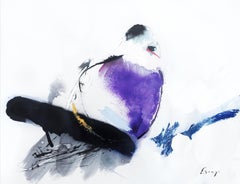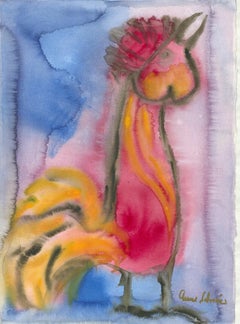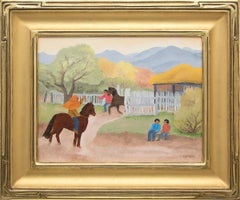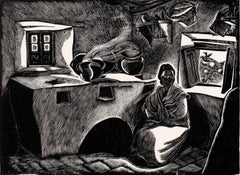Barbara Latham Art
American, 1896-1989
Beginning her career as a commercial artist, Barbara Latham travelled to Taos in 1925 seeking material for a greeting card. Serendipitously, she also found her life partner, Howard Cook, who was similarly looking for ideas for illustrations. Perhaps both were fueled in their quest by the tales of their mutual teacher, Andrew Dasburg, who knew of the energy and stimulation of this artist community. Observing local people and customs, Latham created genre scenes that offer a window into this now-vanished time and place. Her lively illustrations for numerous children’s books are a significant contribution to that graphic art in the mid-20th century.
Born in Walpole, Massachusetts, Latham’s student days included Norwich Art School and Pratt Institute in Brooklyn; but it was contact with the charismatic Dasburg at the Art Students League in Woodstock that opened her world and her view of art. Getting work with companies like Norcross Publishing and Forum magazine, she eventually made her way to Taos. Among all the spirited young artists gathered there, she met Howard Cook, who was designing illustrations for Willa Cather’s Death Comes to the Archbishop. The two married in Santa Fe and began a nomadic life together. The young couple made their way to Paris, a likely destination for modernist artists. Upon receiving a Guggenheim to study fresco painting in 1932, Cook, along with Latham, took an alternative direction and headed to Taxco, Mexico. At this time, Mexican muralists, such as Diego Rivera, were capturing the attention of progressive artists. During the Depression, both Cook and Latham aligned themselves with a populist ideal. Latham contributed work, such as Fording the Stream and Bear Family, to the American Artists Group, which was founded to produce original prints at affordable prices. When Latham settled in Taos, she was committed to an art of and for the people. Rather than a romanticized re-creation, her choice of subjects was based in common everyday activities, favoring those which brought people together. Providing a livelihood, Latham’s illustrations for children’s books reflected her heartfelt belief in the availability of art for all, and her style of open brushwork contributed to a modernist transformation of this graphic art.
After World War II, Latham experimented with Surrealism and abstraction. Many of her painted genre scenes of the fifties simplify forms in order to intensify the interplay of color and shapes. With minimal background, figures are elegantly drawn to an essence, which seems to both capture their actions and take them out of time. Riders on horses have the same linear classicism of Parthenon sculptures, and the brilliance of figure groupings separate them from the background like a frieze.
Latham and Cook had a long-lived marriage, which was grounded in keeping their creative life separate. Latham even confessed that she did not recognize some of her husband’s work upon exhibition. In 1976, the couple moved to Santa Fe, which became their final home.
©David Cook Galleries, LLC(Biography provided by David Cook Galleries)
to
1
2
1
2
2
Overall Height
to
Overall Width
to
2
1
1
1
1
1
1
1
1
2
2
6,857
3,168
2,517
1,217
1
1
1
Artist: Barbara Latham
Saturday Morning (Market, Taos Plaza, New Mexico), 1950s Figural Linocut Print
By Barbara Latham
Located in Denver, CO
1950s modernist linoleum cut print titled 'Saturday Morning (Market, Taos Plaza, New Mexico) by New Mexican artist Barbara Latham. Depicting a busy Saturday morning at the market in Taos Pueblo with horse and cart, Native American figures, adobe buildings and mountains in the background. Presented in a custom frame with all archival materials, outer dimensions measure 16 x 17 ¾ inches. Image size is 8 ½ x 10 ½ inches.
About the Artist:
Beginning her career as a commercial artist, Barbara Latham travelled to Taos in 1925 seeking material for a greeting card. Serendipitously, she also found her life partner, Howard Cook, who was similarly looking for ideas for illustrations. Perhaps both were fueled in their quest by the tales of their mutual teacher, Andrew Dasburg, who knew of the energy and stimulation of this artist community. Observing local people and customs, Latham created genre scenes that offer a window into this now-vanished time and place. Her lively illustrations for numerous children's books are a significant contribution to that graphic art in the mid-20th century.
Born in Walpole, Massachusetts, Latham's student days included Norwich Art School and Pratt Institute in Brooklyn; but it was contact with the charismatic Dasburg at the Art Students League in Woodstock that opened her world and her view of art. Getting work with companies like Norcross Publishing and Forum magazine, she eventually made her way to Taos. Among all the spirited young artists gathered there, she met Howard Cook, who was designing illustrations for Willa Cather's Death Comes to the Archbishop. The two married in Santa Fe and began a nomadic life together.
The young couple made their way to Paris, a likely destination for modernist artists. Upon receiving a Guggenheim to study fresco painting in 1932, Cook, along with Latham, took an alternative direction and headed to Taxco, Mexico. At this time, Mexican muralists, such as Diego Rivera, were capturing the attention of progressive artists. During the Depression, both Cook and Latham aligned themselves with a populist ideal. Latham contributed work, such as "Fording the Stream" and "Bear Family," to the American Artists Group, which was founded to produce original prints at affordable prices. The couple also travelled in the Deep South to the Ozarks and to "Alabama's Black Belt."
When Latham settled in Taos, she was committed to an art of and for the people. Rather than a romanticized re-creation, her choice of subjects was based in common everyday activities, favoring those which brought people together. Taos Pueblo was an ancient, indigenous community, and Latham's view extended that tradition into a contemporary, multi-ethnic village. Sharing some of the spirit of WPA photographs...
Category
Mid-20th Century American Modern Barbara Latham Art
Materials
Linocut
Fish
By Barbara Latham
Located in Dallas, TX
signed "Barbara Latham" at lower left
frame dimensions are 19 x 22 5/8 inches
Category
20th Century Modern Barbara Latham Art
Materials
Watercolor
Related Items
Peace Bird V
Located in ARANJUEZ, ES
Peace Birds is a series of 5 pieces depicting abstract birds.
Rich mix media on paper with vibrant colors and strong pigments , mixing Occidental and orient...
Category
2010s Modern Barbara Latham Art
Materials
Pastel, Ink, Watercolor
Rooster
Located in Kansas City, MO
Anne Schroer
Rooster
watercolor
Signed by hand
Size: 20.1 × 14.6 inches
COA provided (gallery issued)
Anne Schröer was born in Bocholt / Westphalia, Germany in 1931. Post-war she s...
Category
1990s Modern Barbara Latham Art
Materials
Watercolor
Luigi Lucioni, (New England Barn)
By Luigi Lucioni
Located in New York, NY
Painter and printmaker, Luigi Lucioni was known for his portraits, still life paintings, and landscapes of Vermont and Italy. This 'New England Barn' ...
Category
Mid-20th Century American Modern Barbara Latham Art
Materials
Etching
Cats Watching a Witch on a Broomstick - Vintage Halloween Illustration in Ink
By Irene Pattinson
Located in Soquel, CA
Cats Watching a Witch on a Broomstick - Vintage Halloween Illustration in Ink
Halloween scene with cats and a witch in India ink pen by Irene Pattinson (American, 1909-1999). A blac...
Category
1950s American Modern Barbara Latham Art
Materials
Paper, Watercolor, Pen, India Ink
H 18 in W 20 in D 0.25 in
Robert Bonfils Bianchini Ferier 1920 art deco scarf design Bull Fighting: blue
By Robert Bonfils
Located in London, GB
From a series of designs by Robert Bonfils for Bianchini Ferrier, to see some others, scroll down to "More from this Seller" and below it click on "See all from this Seller."
Rober...
Category
1920s Modern Barbara Latham Art
Materials
Carbon Pencil, Gouache
S. L Margolies, Silent Symphony
Located in New York, NY
S. L Margolies (Samuel L.) made dynamic urban views and calm country scenes. This peaceful subject, with snow-covered hills and tidy cabin, Silent Symphony, 1946, marks an end to the...
Category
Mid-20th Century American Modern Barbara Latham Art
Materials
Etching
Pigs on a Trolley - Vintage Picture Book Two-Page Spread Illustration
By Irene Pattinson
Located in Soquel, CA
Pigs on a Trolley - Vintage Picture Book Two-Page Spread Illustration
A two-page spread in India ink pen and watercolor by Irene Pattinson (Ameri...
Category
1950s American Modern Barbara Latham Art
Materials
Paper, India Ink, Watercolor, Pen
H 17 in W 30 in D 0.25 in
Vintage French Modernist Jean Lurcat Watercolor Painting Mod Blue and Orange Owl
By Jean Lurçat
Located in Surfside, FL
Jean Lurcat,New York, France, 1892-1966
Depicts a highly stylized, expressionist owl bird figure hidden in leaves surrounded by bright, vibrant, vivid blue, yellow, and orange colors...
Category
Mid-20th Century Modern Barbara Latham Art
Materials
Watercolor, Lithograph
Irving Guyer, Christmas Trees on Second Street (NYC)
By Irving Guyer
Located in New York, NY
Philadelphia-born Irving Guyer attended the Art Students League and worked in New York City before moving to California. This print is signed and titled i...
Category
1930s American Modern Barbara Latham Art
Materials
Drypoint, Etching
Norman Kent, The Bentley-Kent House, 1831
Located in New York, NY
Signed titled, and dated, in pencil, and annotated in lower margin "My great-great grandfather's house, built in Bentleyville, Ohio in 1831; torn down in 1956."
The wood engraving i...
Category
1960s American Modern Barbara Latham Art
Materials
Lithograph
Down the River
By Thomas Hart Benton
Located in London, GB
A fine impression of this popular Benton image with good margins.
Category
1930s American Modern Barbara Latham Art
Materials
Lithograph
Mary Thomas, Plat-Eye
Located in New York, NY
'Plat-eye' stories are folktales told by African-Americans, particularly in the coastal Gullah areas of Georgia and South Carolina. Typically the plat-eye is an evil spirit who wasn...
Category
Mid-20th Century American Modern Barbara Latham Art
Materials
Intaglio
Previously Available Items
For a Sunday Ride (New Mexico)
By Barbara Latham
Located in Denver, CO
Original vintage oil painting by 20th century New Mexico artist, Barbara Latham (1896-1989), "For a Sunday Ride" depicts a horses and riders in an early autumn New Mexico Landscape w...
Category
20th Century American Modern Barbara Latham Art
Materials
Canvas, Oil
Our Mexican Kitchen
By Barbara Latham
Located in New Orleans, LA
Barbara Latham created this wood engraving of the kitchen in the Taxco, Mexico home she shared with her husband, artist Howard Cook. The house that Barbara and Howard Cook rented from John Evans, the son of Mabel Dodge Luhan, is shown with the Mexican cook who worked for them. It also shows the lemon tree outside their window.
Painter, print maker, and children's book illustrator Barbara Latham was born in Walpole, Massachusetts, in 1896. She was raised in Norwich, Connecticut, and studied at the Norwich Free Academy and then attended Pratt Institute from 1915 to her graduation in 1919. She then studied with Andrew Dasburg at the Art Students League's summer school in Woodstock, New York.
She spent the early part of her career in New York, where she worked for the Norcross Publishing Company and did illustrations for Forum magazine and the New York Times Sunday magazine.
In 1925, Latham went to Taos, New Mexico, for the first time to seek material for illustrations for a greeting card company. She met artist Howard Cook, who was in the process of developing illustrations for Willa Cather's Death Comes to the Archbishop. The couple married in 1927. From 1928 to 1935, they traveled widely including to Mexico; Springfield, Massachusetts; Paris; and Connecticut. In 1933, the couple made their home near Taos. In 1976, they settled in Santa Fe.
Latham created prints and paintings of New Mexico subjects: the Taos landscape, views of the town and genre scenes depicting the seasons of rural life including that of the Taos Indians. She also illustrated children's books and did pencil drawings. Latham's illustrations for children's books included those for Pedro, Nina and Perrito, 1939, and Maggie, which was chosen as one of the best books from the period of 1945 to 1950 by the American Institute of Graphic Arts. One of her paintings, Approaching Storm, c. 1930, is an expressive painting emphasizing the orange of the earth and green of trees against the dark, stormy sky. In style, the painting is a blend of the characteristics of the New Mexico landscape, the colorful approach to landscape developed by the original Taos painters...
Category
1930s American Modern Barbara Latham Art
Materials
Wood, Engraving
Bouquet, Modernist Abstract Painting Coral, Pink, Orange, Yellow, Blue, Green
By Barbara Latham
Located in Denver, CO
Bouquet is an original oil painting by 20th Century New Mexico Modernist woman artist, Barbara Latham (1896-1989), a mid-century modern abstract composition with Coral, Pink, Orange, Yellow, Blue and Green stylized flowers. Presented in a custom frame, outer dimensions measure 25 ½ x 31 ½ x 2 inches; image size is 24 x 29 ¾ inches.
Beginning her career as a commercial artist, Barbara Latham travelled to Taos in 1925 seeking material for a greeting card. Serendipitously, she also found her life partner, Howard Cook, who was similarly looking for ideas for illustrations. Perhaps both were fueled in their quest by the tales of their mutual teacher, Andrew Dasburg, who knew of the energy and stimulation of this artist community. Observing local people and customs, Latham created genre scenes that offer a window into this now-vanished time and place. Her lively illustrations for numerous children’s books are a significant contribution to that graphic art in the mid-20th century.
Born in Walpole, Massachusetts, Latham’s student days included Norwich Art School and Pratt Institute in Brooklyn; but it was contact with the charismatic Dasburg at the Art Students League in Woodstock that opened her world and her view of art. Getting work with companies like Norcross Publishing and Forum magazine, she eventually made her way to Taos. Among all the spirited young artists gathered there, she met Howard Cook, who was designing illustrations for Willa Cather’s Death Comes to the Archbishop. The two married in Santa Fe and began a nomadic life together.
The young couple made their way to Paris, a likely destination for modernist artists. Upon receiving a Guggenheim to study fresco painting in 1932, Cook, along with Latham, took an alternative direction and headed to Taxco, Mexico. At this time, Mexican muralists, such as Diego Rivera, were capturing the attention of progressive artists. During the Depression, both Cook and Latham aligned themselves with a populist ideal. Latham contributed work, such as Fording the Stream and Bear Family, to the American Artists Group, which was founded to produce original prints at affordable prices. The couple also traveled in the Deep South to the Ozarks and to “Alabama’s Black Belt.”
When Latham settled in Taos, she was committed to an art of and for the people. Rather than a romanticized re-creation, her choice of subjects was based in common everyday activities, favoring those which brought people together. Taos Pueblo was an ancient, indigenous community, and Latham’s view extended that tradition into a contemporary, multi-ethnic village. Sharing some of the spirit of WPA photographs...
Category
20th Century American Modern Barbara Latham Art
Materials
Board, Oil
Bear Family
By Barbara Latham
Located in New York, NY
Barbara Latham (1896-1988), Bear Family, 1937, wood engraving, unsigned [signed and dated in the block]. Published by American Artists Group. In excellent condition, on an ivory wove paper, the full sheet with full margins, 10 x 8, the sheet 13 x 18 inches. Window matting, with archival board, unattached mylar hinging.
A fine impression of this charming image.
The American Artists Group was formed in 1934, during the Great Depression, with the express purpose of providing unsigned inexpensive prints which were to be widely distributed. AAG published prints by Ganso, Spruance, Meissner, Ruzicka and Lankes, among many other noted artists. Although the prices of these prints was minimal, sales were sluggish in that economy and editions werenot sold out; most printingswere under 200...
Category
1930s American Realist Barbara Latham Art
Materials
Woodcut
Acequia Madre (New Mexico)
By Barbara Latham
Located in Denver, CO
Oil on canvas. Housed in a custom hand-carved gold leaf frame; outer dimensions measure 17.75 x 29.5 x 1.5 inches. Image measures 12.5 x 24.25 inches.
Provenance:
Private Collection, Colorado
About the Artist:
Beginning her career as a commercial artist, Barbara Latham traveled to Taos in 1925 seeking material for a greeting card. Serendipitously, she also found her life partner, Howard Cook, who was similarly looking for ideas for illustrations. Perhaps both were fueled in their quest by the tales of their mutual teacher, Andrew Dasburg, who knew of the energy and stimulation of this artist community. Observing local people and customs, Latham created genre scenes that offer a window into this now-vanished time and place. Her lively illustrations for numerous children's books are a significant contribution to that graphic art in the mid-20th century.
Born in Walpole, Massachusetts, Latham's student days included Norwich Art School and Pratt Institute in Brooklyn; but it was contact with the charismatic Dasburg at the Art Students League in Woodstock that opened her world and her view of art. Getting work with companies like Norcross Publishing and Forum magazine, she eventually made her way to Taos. Among all the spirited young artists gathered there, she met Howard Cook, who was designing illustrations for Willa Cather's Death Comes to the Archbishop. The two married in Santa Fe and began a nomadic life together.
The young couple made their way to Paris, a likely destination for modernist artists. Upon receiving a Guggenheim to study fresco painting in 1932, Cook, along with Latham, took an alternative direction and headed to Taxco, Mexico. At this time, Mexican muralists, such as Diego Rivera, were capturing the attention of progressive artists. During the Depression, both Cook and Latham aligned themselves with a populist ideal. Latham contributed work, such as "Fording the Stream" and "Bear Family," to the American Artists Group, which was founded to produce original prints at affordable prices. The couple also travelled in the Deep South to the Ozarks and to "Alabama's Black Belt."
When Latham settled in Taos, she was committed to an art of and for the people. Rather than a romanticized re-creation, her choice of subjects was based in common everyday activities, favoring those which brought people together. Taos Pueblo was an ancient, indigenous community, and Latham's view extended that tradition into a contemporary, multi-ethnic village. Sharing some of the spirit of WPA photographs...
Category
20th Century Folk Art Barbara Latham Art
Materials
Oil
Starting on a Rabbit Hunt
By Barbara Latham
Located in Denver, CO
Framed dimensions are 15.5 x 41.5 inches.
Complimentary Shipping within the United States. Contact us for a quote on international shipping. Same Day Shipping and expedited servic...
Category
1950s Modern Barbara Latham Art
Materials
Oil, Masonite
Barbara Latham art for sale on 1stDibs.
Find a wide variety of authentic Barbara Latham art available for sale on 1stDibs. You can also browse by medium to find art by Barbara Latham in linocut, paint, watercolor and more. Much of the original work by this artist or collective was created during the 20th century and is mostly associated with the modern style. Not every interior allows for large Barbara Latham art, so small editions measuring 14 inches across are available. Customers who are interested in this artist might also find the work of John Taylor Arms, Alfred Bendiner, and Samuel Chamberlain. Barbara Latham art prices can differ depending upon medium, time period and other attributes. On 1stDibs, the price for these items starts at $795 and tops out at $1,600, while the average work can sell for $1,198.




